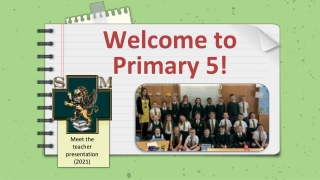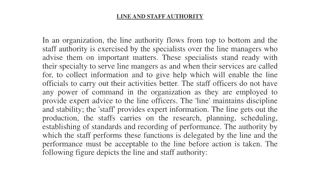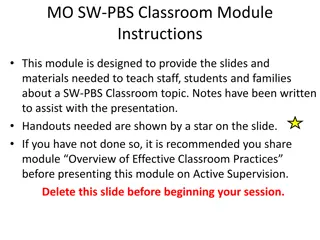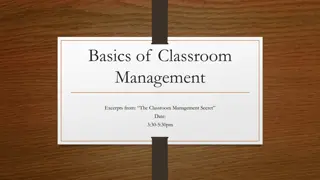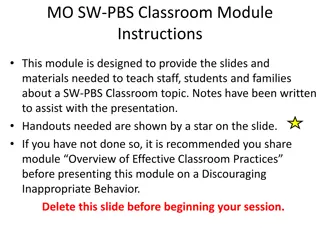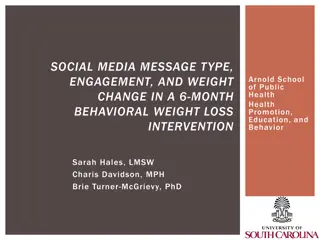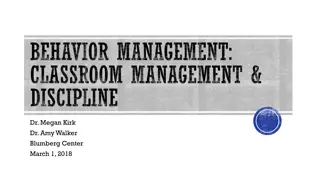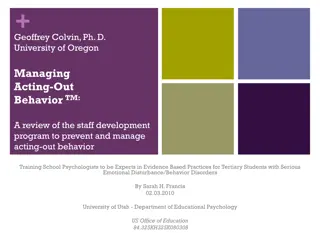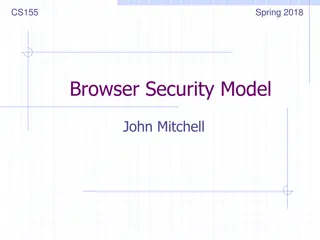
Strategies for Discouraging Inappropriate Behavior in Schools
Learn effective strategies to discourage inappropriate behavior in educational settings, focusing on proactive measures and positive reinforcement. Discover how to address acting-out children, avoid ineffective techniques, and promote a schoolwide system that prioritizes positive behaviors.
Download Presentation

Please find below an Image/Link to download the presentation.
The content on the website is provided AS IS for your information and personal use only. It may not be sold, licensed, or shared on other websites without obtaining consent from the author. If you encounter any issues during the download, it is possible that the publisher has removed the file from their server.
You are allowed to download the files provided on this website for personal or commercial use, subject to the condition that they are used lawfully. All files are the property of their respective owners.
The content on the website is provided AS IS for your information and personal use only. It may not be sold, licensed, or shared on other websites without obtaining consent from the author.
E N D
Presentation Transcript
Staff Mini-Module Developing a Schoolwide System to Discourage Inappropriate Behavior MU Center for SW-PBS College of Education University of Missouri
Unfortunately, most of the practical techniques used by teachers to respond to acting-out children are only of limited effectiveness and some, such as reprimands, arguing, and escalated hostile interactions, can actually strengthen the behaviors they are intended to suppress or terminate. Hill Walker, 1995 The Acting-Out Child: Coping With Classroom Disruption MO SW-PBS MO SW-PBS
The single most commonly used but least effective method for addressing undesirable behavior is to verbally scold and berate a student. Alberto & Troutman High rates of teacher attention to inappropriate behavior is prevalent in our schools. This attention for misbehavior exceeds attention to appropriate behavior, and contributes to the continuation of much problem behavior. White, 1975 MO SW-PBS MO SW-PBS
Instructional Strategies to Discourage Inappropriate Behavior: X Non-Examples How many times do I have to tell you to work quietly? Didn t I just tell you to get started? Why are you talking while I m talking? Do you want me to send you to the office? What do you think you are doing? Quit it right now stop being so antsy! MO SW-PBS MO SW-PBS
General Considerations: Discouraging Inappropriate Behavior Active supervision Consistency Calm, immediate response Specific, yet brief Quiet, respectful contact with student Refocus class, if needed MO SW-PBS MO SW-PBS
Strategies for Staff to Discourage Inappropriate Behavior Indirect Strategies Direct Strategies Additional Consequences Proximity Control Signal/Non- Verbal Cue Ignore/Attend/ Praise Redirect Reteach Provide Choice Student Conference A menu of mild educational responses that require student effort and leave little incentive to repeat the inappropriate behavior. MO SW-PBS
Discouraging Inappropriate Behavior Indirect Strategies Actions to minimize the misbehavior before it gets out of hand and requires more extensive intervention: Proximity Control Signal or Non-Verbal Cue Ignore/Attend/Praise Unobtrusive Carried out quickly during instruction MO SW-PBS MO SW-PBS
Discouraging Inappropriate Behavior Indirect Strategies The strategic placement/movement by the teacher in order to encourage positive behavior. The teacher is a source of protection and strength, helping the student to control impulses. Proximity Control Non-verbal techniques such as sustained eye contact, hand gestures, picture cues, etc. suggesting that the teacher is aware of the behavior and prepared to intervene if it continues. Signal or Non-verbal Cue Uses the power of praise or positive feedback. The teacher praises an appropriately behaving student in the proximity of the inappropriately behaving student. The praise serves as a prompt. When the student exhibits the desired behavior, attention and praise are then provided. Ignore/Attend /Praise MO SW-PBS
Discouraging Inappropriate Behavior Things to remember . . . Address behaviors quickly and calmly. When the student demonstrates the desired behavior, always follow with praise or positive feedback. Use strategically; these indirect techniques are basic stopgap measures and not a substitute for the more in-depth teaching strategies. Re- teach or conference when time permits. MO SW-PBS MO SW-PBS
Discouraging Inappropriate Behavior Direct Strategies A continuum of direct error correction strategies for inappropriate behaviors that continue or do not respond to basic management techniques. Re-Direct Re-Teach Provide Choice Student Conference Direct Interaction using language from the matrix Match to frequency & severity of behavior Done privately Increase rates of teaching and praise MO SW-PBS MO SW-PBS
Four Direct Error Correction Strategies Brief, clear, private verbal reminder of the expected behavior. A re-statement of school-wide and non-classroom behavior, or classroom procedure. Re-Direct Builds on the re-direct by specifically describing the steps required to instructing the student on exactly what should be done. Re-Teach Can be used when a re-direct or re-teaching have not worked. A statement of two alternatives the preferred or desired behavior or a less preferred choice. Provide Choice Lengthier re-teaching or problem solving. Discusses the behavior of concern, teaches the desired behavior, provides reasons why it is important, and a plan is made for future use. Can include role-play or practice. Student Conference MO SW-PBS
Re-Direct Julia is talking to the student beside her instead of working on an independent writing assignment. Quietly walk to Julia and say, Remember to be responsible by following directions and starting on your writing task. Thank you. Walk away to give Julia time to comply. The teacher assigns work on p. 182 in the math book. Austin takes out paper and begins drawing. Quietly walk to Austin and respectfully say, Please, follow directions by getting out your math book and opening to p. 182. You can finish drawing at the end of the day. Walk away to give Austin time to comply. MO SW-PBS
Re-Teach Julia continues to talk after the teacher redirects her to begin working. The teacher returns to Julia and quietly says, Please show me how you will follow directions by first getting out your writing materials. Now show me how you work quietly. Please let me know if you need help. Thank Julia after she begins working. Austin gets out his book, but continues to draw. The teacher returns to Austin and quietly says, Thank you for getting out your book. Now remember, to complete your work, clear your desk of everything but the book and math notebook, begin working right away and continue working until done. If you need help, raise your hand. (Pause and look away to give Austin time to comply.) MO SW-PBS MO SW-PBS
Provide Choice Julia, you are having difficulty working by _______. You can choose to work at the writing center or in the student office. I ll be back in a few seconds to hear your decision. Austin, you are having difficulty starting your math work. You can choose to work on the assignment or on an alternate math activity. I ll be back in a few seconds to hear your decision. MO SW-PBS MO SW-PBS
Student Conference Julia, can you please tell me what you need to do to start writing as directed? (If Julia can tell you, provide specific positive feedback. If not, restate the steps, one at a time: 1. Keep mouth and body quiet so you can hear the directions. 2. Get out needed materials. 3. Think about what you will write, and create a graphic organizer. 4. Ask for help if you need it to finish the work.) Julia, tell me what you ll do the next time you re directed to work on a writing assignment. (Julia responds.) Tell me what I can do to help you to follow directions to start and complete the writing assignment. (Julia responds.) We ll practice again after lunch. MO SW-PBS MO SW-PBS
Student Conference Austin, several times today you have been drawing during work time. Austin, can you tell me the steps you need to follow when you re directed to work on an assignment? (If Austin can tell you the steps, provide specific positive feedback. If he cannot, restate the steps one at a time.) When you follow directions to start and finish work, you can get done what you have to do quickly and then move on to things you enjoy. You may also have less homework. Austin, tell me what you will do next time you are given an assignment. (Austin responds) MO SW-PBS MO SW-PBS
Student Conference cont. How can I help you to do that? (Austin responds) You re going to have another opportunity to practice this later this afternoon. Do I have your commitment to do what we ve talked about? Thanks for listening. You did a nice job accepting some feedback. I m going to be watching to see if I can catch you on-task. MO SW-PBS
Considerations for Corrective Feedback Always correct privately; use preferred adult behaviors that maintain respect for the student. Use the strategy that is the least intrusive for the behavior and its frequency or severity. Create an environment where corrective feedback is used to improve behavior in a positive manner. When inappropriate behavior occurs, increase teaching (lessons, pre-corrects) and rates of encouragement (positive feedback). MO SW-PBS MO SW-PBS
Some Possible Additional Consequences Phone call to parents Restitution Make up missed work Teach others Mediation essay Alter activity Make amends to others Loss of privilege Contract Office referral Parent conferences MO SW-PBS

